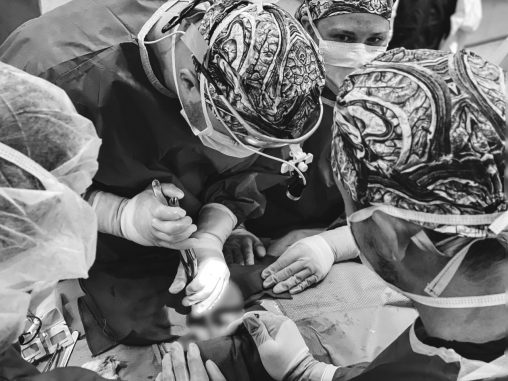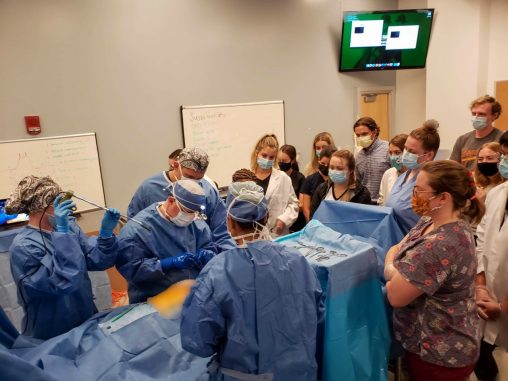
A group of Boonshoft School of Medicine students held four surgical workshops for undergraduate and premedical students over the summer.
Medical students at the Wright State University Boonshoft School of Medicine organized an innovative series of surgical workshops for undergraduate and premedical students.
The Boonshoft School of Medicine students conducted four half-day surgical workshops over the summer focusing on neurosurgical, trauma and transplant. Five medical students performed and taught each case.
Each workshop was attended by 20 to 30 undergraduate students who learned about pre-, intra, and post-operative management; anatomy of the surgical cases; and general operative workflow. Some of the students also learned how to perform basic sewing techniques during a suturing lab.
The workshops were held in the Boonshoft School of Medicine anatomy lab, which was transformed into a fully functional operating room with video output that allowed the students to closely watch the procedures. The cases were performed on human donors from the School of Medicine’s Anatomical Gift Program.
Alex Gilman, a second-year medical student, said the medical students created the workshops to apply some of the lessons they have learned at Wright State.
“Mentorship, service and community are some of the most vital qualities taught at Boonshoft School of Medicine,” said Gilman, who acted as the student surgeon during the workshops.
The workshops were led by Gilman and second-year medical students Kenzie Lundquist, Donald Hefelfinger and Izzy Ely; Phil Walker, an M.D./Ph.D. student; and Wright State undergraduate teaching assistants Reagan Clark and Maura Piroch. Bridgett Severt, a lecturer of anatomy in the Department of Neuroscience, Cell Biology and Physiology (NCBP), supervised the students in the lab.
The medical students and teaching assistants performed various roles during the workshops, including conducting the surgical cases, assisting with the operating room workflow and scrubbing techniques.
Gilman, who is president of the Neurosurgery Interest Group (AANS Chapter) at the School of Medicine, spent most of the summer researching the appropriate surgical cases, working with physician advisors and performing hands-on training in the anatomy lab with Severt to ensure that the workshops were successful.
Helping the medical students organize the workshops were Severt; Robert Lober, M.D., Ph.D., assistant professor of pediatrics and NCBP, as well as a neurosurgeon at Dayton Children’s; and Barbara Kraszpulska, Ph.D., associate professor of neuroscience, cell biology and physiology.
A radiologist, operating room and emergency room nurses, and an ultrasound technologist from the United States Air Force assisted during the events. Paul Koles, M.D., a pathologist at the Boonshoft School of Medicine also provided assistance.
The undergraduate participants expressed interest in attending similar events in the future and said the summer surgical workshops inspired them to pursue surgery, medicine and patient care, Gilman said.
“As an inaugural event, the workshops were a grandiose success and opened doors to improve and enhance next year’s workshops,” Gilman said.


 Wright State psychology team studies ways to identify fatigue in pilots, drivers
Wright State psychology team studies ways to identify fatigue in pilots, drivers  Wright State videographer Kris Sproles wins Regional Emmy and Ohio journalism award
Wright State videographer Kris Sproles wins Regional Emmy and Ohio journalism award  Wright State Boonshoft School of Medicine ranked among the nation’s best for 2024 by U.S. News
Wright State Boonshoft School of Medicine ranked among the nation’s best for 2024 by U.S. News  Exposing biotechnology
Exposing biotechnology  Wright State faculty member Dan Noel uses unique background to inspire new leaders
Wright State faculty member Dan Noel uses unique background to inspire new leaders 